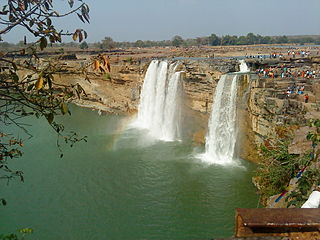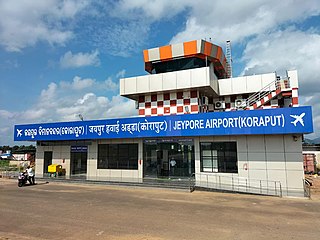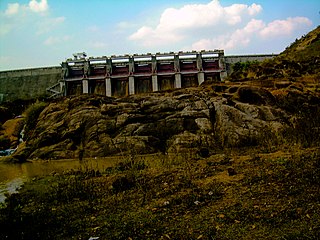
Jeypore is one of the largest towns and a place of historical significance in Koraput district in the Indian state of Odisha. It was established by Vir Vikram Dev in the mid 17th century. The kingdom was defeated by the East India Company in 1777 who declared it a Zamindari or Feudatory of the British Crown and much later got acknowledged as a Princely state until its dissolution in the Dominion of India in 1947.

Koraput district is a district of India in southern Odisha, with headquarters at Koraput. The district is located in the Eastern Ghats and is known for its hilly terrain, rich and diverse types of mineral deposits and its tribal culture and traditions. The district headquarters town of Koraput and its largest city, Jeypore are major centres of trade and commerce for South Odisha and fall on an important road connecting Visakhapatnam to Raipur.

Indravati River is a tributary of the Godavari River, in central India.

Kalahandi district is a district of western Odisha in India.
The Jalaput Dam is a hydroelectric dam built on the Machkund River, a tributary of the Godavari River in India which rises in the Mudugal hills of Alluri Sitharama Raju district District and nearby Ondra Gadda it becomes the boundary between Andhra Pradesh and Odisha. This Dam is the most ignored one in India, currently, it is in dilapidated condition. For over 48 km the river runs nearly north along a meandering course through the Padwa Valley. About 48 km south of Jeypore, it winds westward along the edge of the Plateau and then suddenly tums at a short angle to the south-west down a steep descent popularly known as Duduma Falls.

The Godavari River has its catchment area in seven states of India: Maharashtra, Telangana, Chhattisgarh, Madhya Pradesh, Andhra Pradesh, Karnataka and Odisha. The number of dams constructed in Godavari basin is the highest among all the river basins in India. Nearly 350 major and medium dams and barrages had been constructed in the river basin by the year 2012.
The Balimela Reservoir is located in Malkangiri district, Odisha, India on the river Sileru which is a tributary of the Godavari river. The gross storage capacity of Balimela reservoir is 3610 million cubic meters.

Koraput is a town and a Municipality in Koraput district in the Indian state of Odisha. Koraput town is the district headquarter of Koraput district.
Malkangiri, historically known as Malikamardhangiri, is a town and municipality in Malkangiri district in the Indian state of Odisha. It is the headquarter of the Malkangiri district. Malkangiri has been the new home of the East Bengali refugees from erstwhile East Pakistan, who have been rehabilitated since 1965 under the Dandakaranya Project. Some Sri Lankan Tamil refugees were also rehabilitated in the town, following the armed struggle of the Liberation Tigers of Tamil Eelam (LTTE) in the early 1990s, although most of them have now returned to their country. Currently, it is one of the most naxalite-affected areas of the state, and is a part of the Red Corridor.

The River Nagavali also known as Langulya is one of the main rivers of Southern Odisha and Andhra States in India, between Rushikulya and Godavari basins.

Odisha is one of the 28 states in the Republic of India. Odisha is located in the eastern part of the Indian peninsula and the Bay of Bengal lies to its East while Chhattisgarh shares its border in the west and north-west. The state also shares geographic boundaries with West Bengal in the north-east, Jharkhand in the north and Andhra Pradesh in the south. The state is spread over an area of 1,55,707 km2 and extends for 700 km from north to south and 500 kilometres from east to west. Its coastline is 450 km long. The state is divided into 30 districts which are further subdivided into 314 blocks.

Sabari River is one of the main tributaries of Godavari. It originates from the western slopes of Eastern Ghats in Odisha state from Sinkaram hill ranges at 1374 m MSL. It is also known as Kolab river in Odisha.The Sabari river basin receives nearly 1250 mm annual average rainfall. It forms common boundary between Chhattisgarh and Odisha states. It later enters into Andhra Pradesh to merge with River Godavari. Upper Kolab project, located in Odisha across the Sabari is a major dam project supplying water for irrigation and Hydro power generation.
Sileru River is a tributary of Sabari River in southern India. It originates in Andhra Pradesh and also flows through Odisha before merging with Sabari. Sabari river crosses the border into Andhra Pradesh to merge with Godavari river. Sileru river joins Sabari river tri-junction boundary point of Andhra Pradesh, Chhattisgarh and Odisha.

Bhubaneswar Behera was an engineer, writer and scholar from the Kalahandi district of Odisha.

The Polavaram Project is an under construction multi-purpose irrigation project on the Godavari River in the Eluru District and East Godavari District in Andhra Pradesh. The project has been accorded National project status by the Central Government of India. Its reservoir back water spreads up to the Dummugudem Anicut and approx 115 km on Sabari River side. Thus back water spreads into parts of Chhattisgarh and Odisha States. It gives major boost to tourism sector in Godavari Districts as the reservoir covers the famous Papikonda National Park, Polavaram hydro electric project (HEP) and National Waterway 4 are under construction on left side of the river. It is located 40 km to the upstream of Sir Arthur Cotton Barrage in Rajamahendravaram City and 25 km from Rajahmundry Airport.

The Government of India (GoI) constituted a common tribunal on 10 April 1969 to solve the river water utilization disputes about the river basin states of Godavari and Krishna rivers under the provisions of Interstate River Water Disputes Act – 1956. The common tribunal was headed by Sri RS Bachawat as its chairman with Sri DM Bhandari and Sri DM Sen as its members. Godavari river basin spreads through the states of Telangana (TS), Maharashtra (MR), Orissa, old Madhya Pradesh {later bifurcated into present Madhya Pradesh (MP) and Chhattisgarh}, Karnataka (K) and Andhra Pradesh (AP). Krishna river basin states Maharashtra, Karnataka and Andhra Pradesh insisted on the quicker verdict as it had become more expedient for the construction of irrigation projects in Krishna basin. So the Godavari Water Disputes Tribunal (GWDT) could not proceed till the Krishna Water Disputes Tribunal final verdict was submitted to GoI on 27 May 1976.

Jeypore Airport, also known as Jayapur Airport, is a domestic airport serving the cities of Jeypore and Koraput in Odisha, India. It is located 3 km (1.9 mi) north-west of the city of Jeypore in Koraput District. The airstrip was constructed in 1962 along with the establishment of a Hindustan Aeronautics Limited (HAL) factory nearby at Sunabeda. In the 1980s, Vayudoot operated a daily Bhubaneswar-bound flight via Visakhapatnam. Now, the new low-cost regional airline, IndiaOne Air, operates from the airport to Bhubaneswar and Vishakapatnam.

The Purna River is a major left-bank tributary of Godavari River originating in the Ajanta Range of hills in Aurangabad District, Maharashtra.The river lies in the rain shadow region of Maharashtra, on the Deccan Plateau, flowing through the districts of Aurangabad, Buldana, Jalna, Hingoli and Parbhani with a large catchment area measuring about 15,579 km2. This enormous catchment area is often tagged as a sub-basin of Godavari River and along with its tributaries forms a dendritic drainage pattern. It is a prime river in the Marathwada region of Maharashtra running for about 373 km before it converges with Godavari River south of Purna city in the Parbhani district.

Indravati Dam is a gravity dam on the Indravati River a tributary of Godavari, about 90 km from Bhawanipatna in the state of Odisha in India. It is connected to the main Indravati reservoir via 4.32 km long and 7 m dia head race tunnel designed for a discharge capacity of 210 cumecs and terminating in a surge shaft. Currently it is the largest power producing dam in eastern India with a capacity of 600 MW.
The Kakkad Hydroelectric Power Plant is located near Seethathode, in the Pathanamthitta district of the Indian state of Kerala. It is operated by the Kerala State Electricity Board.






















